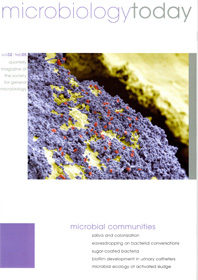Microbial Communities
01 February 2005 publication
The lead articles of the February 2005 issue of Microbiology Today are on saliva and colonisation; eavesdropping on bacterial conversations; sugar-coated bacteria; biofilm development in urinary catheters; and microbial ecology of activated sludge.
Living together: microbial communities (p. 08)
This introduction, by Hilary Lappin-Scott and Sarah Burton, to the special issue on communities covers some of the relevant got topics currently studied by microbiologists.
Let it flow but don't let go (p. 10)
Every time we clean our teeth, the biofilm has to reform. Paul Kolenbrander and others explain how molecular signalling between the plaque bacteria seem to be crucial to this process.
Eavesdropping on bacterial conversations (p. 14)
Marine biofouling costs millions of dollars a year. Ian Joint and Karen Tait discuss how, amazingly, seaweeds are using quorum sensing molecules from bacteria to locate suitable sites for attachment and growth.
Sugar-coated bacteria (p. 18)
Jackie Parry describes how many protozoa can get through the sugary matrix of a biofilm and feed on the bacteria inside, yet the bacteria seem to be biting back and exploiting the grazers for their own benefit.
Urinary catheters (p. 22)
Biofilms containing pathogenic bacteria soon develop in urinary catheters, leading to nasty infections. David Stickler wonders what can be done to solve this distressing problem?
The Biofilm Club (p. 26)
Mat Upton explains that this organisation provides a meeting ground for researchers into microbial communities.
Microbial ecology of activated sludge (p. 28)
The activated sludge process relies on a complex community of microbes to clean up wastewaters. Michael Wagner discusses how new molecular tools are providing vital information to improve the treatment.
Schoolzone (p. 34)
Faye Jones explains how the system that lets organisms communicate with each other with chemical signals, called quorum sensing, works.
Gradline (p. 36)
Jane Westwell gives advice to students coming to the end of their degree, with information about the range of opportunities gleaned from some major UK recruitment agencies.
Going public (p. 40)
Faye Jones reports on some of the activities the Society was involved in, including Science and the Parliament.
Obituary (p. 47)
John Guest and Howard Gest describe the highlights of the late June Lascelles's life, who passed away in July.
Comment - MRSA - national disgrace (p. 48)
MRSA is always in the news, but as Mark Enright explains, improvements to hospital hygiene are not the only measures needed to make this health hazard go away.
Cover image credit: Mona Lisa Production/Science Photo Library



